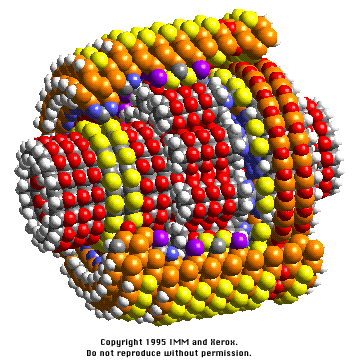Technical information on the molecular planetary gear

This page provides more technical information about the planetary
gear than the non-technical introductory page.
The current version of the planetary gear is available in
three formats:
Molecular Dynamics
Several people have expressed interest in performing molecular dynamics
calculations on the planetary gear. As several important properties
of the planetary gear are currently not well understood (including the
maximum speed of operation that is feasible, the maximum torque that
can be applied, etc) the "best" modeling conditions are not currently
known.
At the most basic level, the maximum 0 kelvin static torque is not known,
and is likely to vary at least somewhat with the particular potential energy
function used. To determine the maximum static torque, it is necessary to:
- Prevent rotation of the planet carrier.
- Prevent rotation of the casing.
- Apply a known torque to the sun gear.
- Optimize the geometry by minimizing the energy.
- Determine whether the planetary gear failed (by visual inspection).
- Increase or decrease the torque as appropriate, and go to step 3.
There are several ways of doing items 1 and 2, the simplest being
to select some subset of the atoms in the planet carrier and casing
and freezing their locations. The chosen atoms should preferably
be as remote from the active part of the planetary gear as feasible.
Several other methods could be used.
Item 3 can be done in one of two ways: actually apply a torque to
the sun gear and minimize, presumably by applying the desired force
to a subset of the atoms of the sun gear (again, as far removed
from the active region of the planetary gear as feasible); or
alternatively by selecting a subset of the atoms in the sun
gear, rotating them by some small amount, freezing their locations,
and minimizing. After minimization, the forces on the frozen
atoms would permit computation of the applied torque.
Note that the maximum 0 kelvin static torque that can be tolerated by
the planetary gear will differ from the static torque that could be
tolerated at some higher temperature (such as 300 kelvins), as thermal
noise implies that there will be some finite probability that the
planetary gear will fail (slip a gear, break off a planet, or whatever)
when the applied torque is significantly lower than the maximum
0 kelvin static torque. Presumably, if the applied static torque is
sufficiently reduced, the probability of failure at higher temperatures
can be made very small -- unless, of course, the barrier against
failure is of the same order of magnitude as kT. This
is hopefully unlikely with the current structure at "reasonable"
operating temperatures.
Once knowing the maximum 0 kelvin static torque that can be applied,
the planetary gear could be accelerated from rest to higher and higher
rotational speeds by:
- Preventing rotation of the casing.
- Applying a torque that is a modest fraction of
the maximum 0 kelvin static torque (perhaps 5%).
- Watching the planetary gear accelerate to higher
and higher rotational speeds, until
- At some sufficiently high speed, the planetary gear fails
(note that the use of a Morse potential for bonds would likely result in
a particularly spectacular failure mode....)
Another method of determining whether or not the planetary gear will
function at a given frequency would be to start all components of
the structure moving with approximately the correct velocities,
and then observe the resulting behavior. This, of course,
requires that we be able to generate some approximation to
the correct initial velocities for each atom. This might
be done in the following manner:
- Starting with the minimized structure, rotate each planet
clockwise by 0.1 "teeth".
- Rotate the casing clockwise by 0.1 "teeth".
- Rotate the sun gear counterclockwise by 0.1 "teeth".
- Minimize the new structure.
- Align the casing of the new structure with the casing
of the old structure.
- For each atom, compute the difference between its old
position and its new position.
- Treat the resulting vectors as an approximation to the
direction of motion of each atom during normal movement
of the planetary gear.
- Scale the velocity vectors to correspond with the desired
frequency of operation (and perhaps add "thermal noise"
to the velocity vectors, corresponding to the desired
temperature of operation, e.g., 300 kelvins).
- Prevent rotation of the casing.
- Apply the proper fixed rotational speed to a subset of atoms
selected from the sun gear.
- Use molecular dynamics to watch the behavior of the resulting
system. Again, use of the Morse potential for bonds should result
in a spectacular display when the planetary gear is operated at
a sufficiently high frequency.
The rotation by "teeth" is a convenient measure, but for each component
the actual angular rotation to apply will be different.
- For the planets, which have 6 teeth, 0.1 "teeth"
is a rotation of (1/6) x 0.1 x 360 = 6 degrees.
- For the sungear, which has 16 teeth,
0.1 "teeth" is (1/16) x 0.1 x 360 = 2.25 degrees.
- For the casing, which has 29
teeth, 0.1 "teeth" is (1/29) x 0.1 x 360 ~ 1.24 degrees.
Molecular dynamics both of normal operation and of
failure modes should be interesting, and the resulting
videos are likely to show quite graphically what types
of failure occur first. The failure modes will presumably
suggest design changes which would permit higher speed
(or higher torque) operation; or otherwise suggest
design improvements.
A simulation of the original planetary gear in which the
sungear was given an instantaneous initial rotational
speed of 500 gigahertz
was done at Caltech. Under these conditions, the original
design did not
work satisfactorily, exhibiting frequent slippages.
It is quite plausible that the
current design would fail under such conditions as well.

